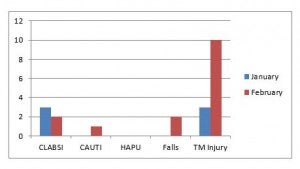What is the “Big 6?”
If you have recently walked by the Children’s Hospital Situation Room on 7 West, you might have noticed the words “The Big 6” hand written across one of the walls. Each month at the Children’s Hospital Outcomes & Operations Team (CHOOT) Meeting, we discuss the “Big 6” and our current progress on improving outcomes. So what are these so-called Big 6? Some of you may remember the Medical Center’s Q17 – quality and safety priorities. With the introduction of Be Safe, it was decided to “lean” our priorities to better utilize resources and focus on problem areas. The Big 6 are:
- Mortality – Specifically, reducing risk-adjusted mortality. The medical center’s goal is to achieve or exceed the top quartile of the University Hospital Consortium (UHC) Indexed Mortality. Every patient has an expected risk of mortality based on their diagnosis at admission, with most Children’s Hospital patients having a very low risk.
- Catheter associated urinary tract infection (CAUTI) – Urinary tract infections (UTI) that are associated with indwelling urinary catheters. Our goal is to Chase Zero.
- Central line associated blood stream infection (CLABSI) – Blood stream infections that are associated with indwelling central lines. Our goal is to Chase Zero. This is a major focus within the Children’s Hospital and we are specifically focusing on standardizing how central lines are inserted and maintained across the hospital.
- Healthcare acquired pressure ulcer (HAPU) – Healthcare acquired pressure ulcers can double or triple lengths of stay and hospital costs. This is less likely to occur in children but we are still focused on preventing these injuries in our patients
- Patient falls with injury – Injuries from falls in hospitalized patients are a frequent occurrence in adult medicine and many protocols have been put in place to help prevent these from occurring. However, even though these data exclude falls that are “developmental” in nature (think of the toddler running around!), they still occur on the 7th Floor and are preventable.
- Team member injuries – Some may be wondering what this has to do with the quality of care we deliver in the Children’s Hospital? If you or your colleagues do not feel safe when coming to work, then there is a problem. Nobody should feel threatened at work or have to deal with an injury occurring on the job. If we are worried about our safety, how can we provide the best care possible to our patients?
The Children’s Hospital is following these data closely. In a sense, it is a measure of the harm that has come to our patients while hospitalized as well as to our colleagues while they are on the job. By focusing on these areas, we hope to achieve ZERO harm events across the hospital to our patients and our team members. Here are the Children’s Hospital data for January and February 2015. Let’s work together to achieve zero harm!
QSLAM Course
UVA’s Quality & Safety Leadership in Academic Medicine Course is being offered again this April 17th and 18th. It is intended to complement and/or augment current training in the Be Safe program. The course faculty (including Dr. Hoke from the Department of Pediatrics) will discuss the basic science of quality improvement and patient safety and how to lead change in complex organizations. It will draw on some of the real-world experiences of nurses and physicians at UVA. If you are interested in attending, please contact Jon Swanson at jswanson@virginia.edu.
Filed Under: Features
Tags: jrs3yc

